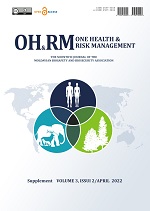Résumé
Introduction. In the Republic of Moldova, the population is supplied with drinking water from surface sources, which is mainly provided from the basins of the Dniester and Prut rivers, where the water quality varies greatly. Apart from these two cross-border rivers, in accordance with Government Decision no. 890 of 12.11.2013 on the approval of the Regulation on environmental quality requirements for surface water, the National Agency for Public Health also monitors the quality of surface water from sources used for recreation and irrigation.
Material and methods. 379 water samples from fixed points along the Dniester and Prut rivers were investigated for sanitary-hygienic and microbiological indicators. Hygienic, statistical, descriptive and analytical methods were used within the study.
Results. During 2020, in order to monitor the quality of surface water, 379 samples were taken and investigated for chemical and sanitary parameters (Dniester River – 70 samples, Prut River – 50 samples, sources used for recreation – 101 samples, sources used for irrigation – 35 samples and other sources – 123 samples) and 428 samples were assessed for microbiological parameters (Dniester River – 89 samples, Prut River – 47 samples, sources used for recreation – 143 samples, sources used for irrigation – 56 samples and other sources – 56 samples). The results of the laboratory investigations of the monitored surface sources show that, depending on the sanitary-chemical indicators, the largest share of samples was related to quality class I and II (very good and good) to which the Prut water was attached (66.0%), water from irrigation sources (53.0%) and water from the Dniester River (50.0%). Furthermore, it is worth mentioning that 40.0% of samples from the Prut district were classified as being quality class IV and V (polluted and highly polluted). This share was 5.7 times higher compared to the water quality in the Dniester River, the estimated index being of 7.0%. The main indicators according to which the water was classified as polluted and highly polluted were the turbidity and the parameters of the oxygen regime, which are largely influenced by the hydrometeriological conditions. Thus, it should be concluded that the Prut River water is much more vulnerable to climatic changes compared to the Dniester River water, which has a higher self-purification capacity. Microbiological investigations of surface water quality were performed using the following parameters: total coliform bacteria, E. coli, intestinal enterococci, pathogenic microorganisms (Salmonella, Shigella, Vibrioholera), Colifagi. The results of the investigation showed a permanent pollution of the water basins with wastewater and other organic pollutants. Stable pathogenic microflora was detected in the water basins. In 2020, out of the total number of samples investigated for microbiological parameters, 9.0% of the pathogenic microflora was detected in the Dniester River, 8.4% - in water basins used for recreation and 3.2% in other water basins.
Conclusions. There has been a sharp decline in the quality of surface water in these two rivers due to anthropogenic pollution with untreated or partially treated wastewater.
|
 Vues: 436|
|
Vues: 436|
|
Ce travail est disponible sous la licence Creative Commons Attribution 4.0 International .

